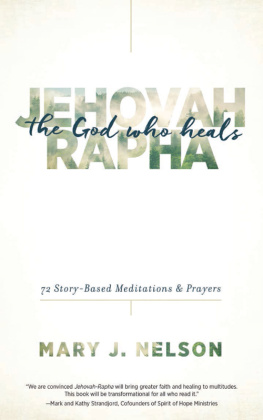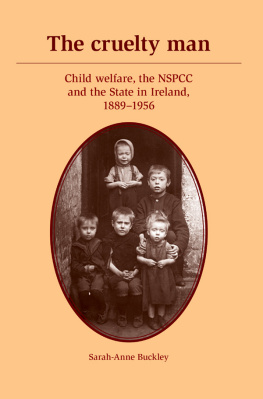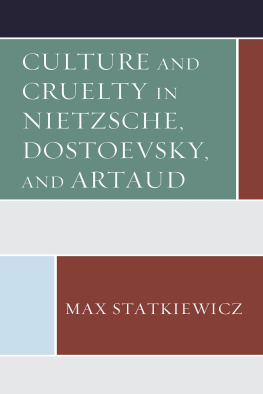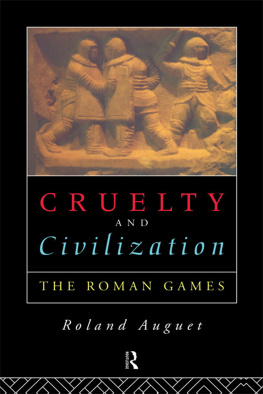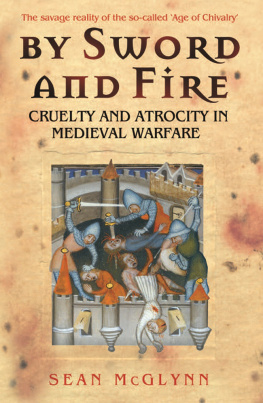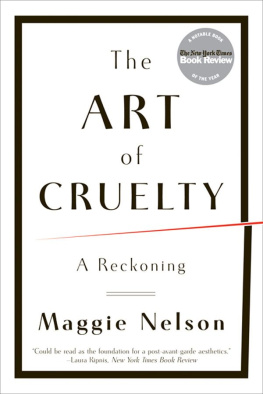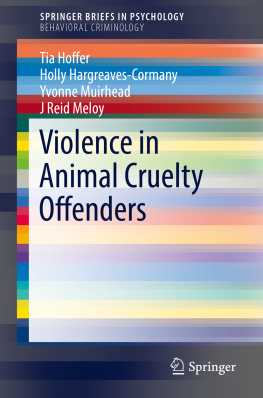Nelson - The art of cruelty: a reckoning
Here you can read online Nelson - The art of cruelty: a reckoning full text of the book (entire story) in english for free. Download pdf and epub, get meaning, cover and reviews about this ebook. City: New York, year: 2011, publisher: W. W. Norton & Company, genre: Art. Description of the work, (preface) as well as reviews are available. Best literature library LitArk.com created for fans of good reading and offers a wide selection of genres:
Romance novel
Science fiction
Adventure
Detective
Science
History
Home and family
Prose
Art
Politics
Computer
Non-fiction
Religion
Business
Children
Humor
Choose a favorite category and find really read worthwhile books. Enjoy immersion in the world of imagination, feel the emotions of the characters or learn something new for yourself, make an fascinating discovery.

The art of cruelty: a reckoning: summary, description and annotation
We offer to read an annotation, description, summary or preface (depends on what the author of the book "The art of cruelty: a reckoning" wrote himself). If you haven't found the necessary information about the book — write in the comments, we will try to find it.
Nelson: author's other books
Who wrote The art of cruelty: a reckoning? Find out the surname, the name of the author of the book and a list of all author's works by series.
The art of cruelty: a reckoning — read online for free the complete book (whole text) full work
Below is the text of the book, divided by pages. System saving the place of the last page read, allows you to conveniently read the book "The art of cruelty: a reckoning" online for free, without having to search again every time where you left off. Put a bookmark, and you can go to the page where you finished reading at any time.
Font size:
Interval:
Bookmark:
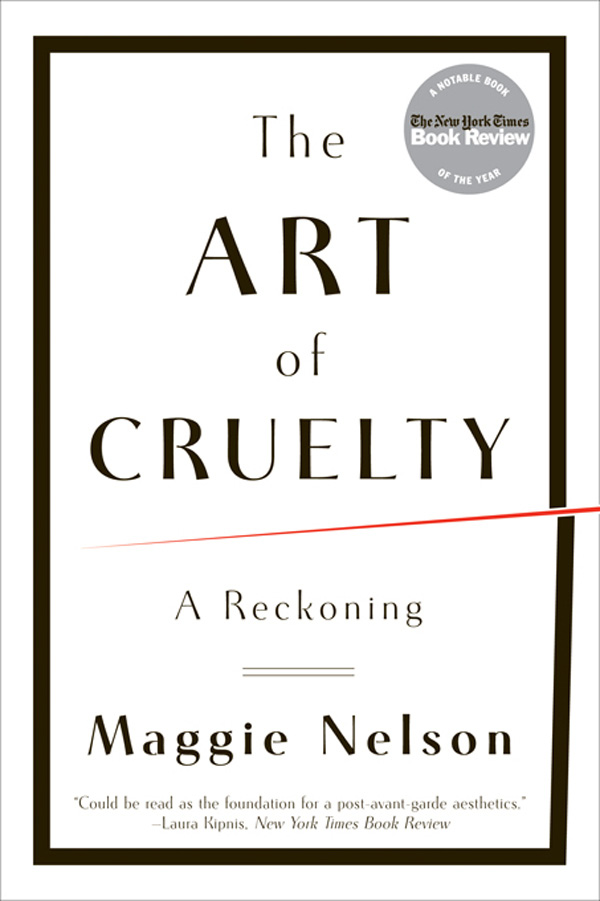
ALSO BY M AGGIE N ELSON
Bluets
Women, the New York School, and Other True Abstractions
The Red Parts: A Memoir
Jane: A Murder
Something Bright, Then Holes
The Latest Winter
Shiner
The Art
of Cruelty

A R ECKONING
Maggie Nelson
W.W. NORTON & COMPANY
NEW YORK LONDON
Copyright 2011 by Maggie Nelson
All rights reserved
First printed as a Norton paperback 2012
Lustmord by Jenny Holzer. Copyright 2010 Jenny Holzer, member Artists Rights Society (ARS), New York. Asphodel, That Greeny Flower by William Carlos Williams, from The Collected
Poems: Volume II, 19391962 . Copyright 1944 by William Carlos Williams. Reprinted by permission of New Directions Publishing Corp. The Ivy Crown by William Carlos Williams, from The Collected Poems: Volume II, 19391962 . Copyright 1953 by William Carlos Williams. Reprinted by permission of New Directions Publishing Corp. Her Beckett from Decreation by Anne Carson. Copyright 2005 by Anne Carson. Used by permission of Alfred A. Knopf, a division of Random House, Inc. Brief excerpts from various Sylvia Plath poems from The Collected Poems of Sylvia Plath, edited by Ted Hughes. Copyright 1960, 1965, 1971, 1981 by the Estate of Sylvia Plath. Editorial material copyright 1981 by Ted Hughes. Reprinted by permission of HarperCollins Publishers (from Getting There, Fever 103, Elm, Tulips, The Surgeon at 2 a.m., Lesbos, Three Women, Little Fugue, The Detective, Lady Lazarus, Daddy, The Rabbit Catcher, The Jailer, Event, Poem for a Birthday, The Moon and the Yew Tree). Brief excerpts from Ariel and Years from Ariel: Poems by Sylvia Plath . Copyright 1961, 1962, 1963, 1964, 1965, 1966 by Ted Hughes. Foreword by Robert Lowell. Reprinted by permission of HarperCollins Publishers and Faber and Faber, Ltd.
For information about permission to reproduce selections from this book,
write to Permissions, W. W. Norton & Company, Inc.,
500 Fifth Avenue, New York, NY 10110
For information about special discounts for bulk purchases, please contact
W. W. Norton Special Sales at specialsales@wwnorton.com or 800-233-4830
Book design by Dana Sloan
Production manager: Julia Druskin
Library of Congress Cataloging-in-Publication Data
Nelson, Maggie, 1973
The art of cruelty : a reckoning / Maggie Nelson. 1st ed.
p. cm.
Includes bibliographical references and index.
ISBN 978-0-393-07215-0 (hardcover)
1. Cruelty in art. 2. ArtMoral and ethical aspects. I. Title. II. Title: Reckoning.
N8217.C792N45 2011
700'.453dc22
2011001828
ISBN 978-0-393-34314-4 pbk.
eISBN 978-0-393-08223-4
W. W. Norton & Company, Inc.
500 Fifth Avenue, New York, N.Y. 10110
www.wwnorton.com
W. W. Norton & Company Ltd.
Castle House, 75/76 Wells Street, London W1T 3QT
1 2 3 4 5 6 7 8 9 0
For Annie Dillard, who advises otherwise.
Contents
STYLES OF IMPRISONMENT
O NE SHOULD open ones eyes and take a new look at cruelty, Friedrich Nietzsche exhorted in Beyond Good and Evil (1886), in which Nietzsche famously attempts to lay waste to traditional notions of morality, especially those associated with Christianity. Nietzsche hoped that, in catapulting beyond the poles of good and evil, kindness and cruelty, the true energy and strength of mankind would be liberated: in art as in life, this energywhich Nietzsche termed our will to powerwould pour forth; it would dance; it would shine.
The next centurywith its unthinkable wars, premeditated and spontaneous genocides, rapacious exploitation of resources, environmental catastrophes, and systemic injustices of all kindsprovided ample opportunity to take this new look. Many of the centurys art movements (Futurism, Dada, Surrealism, Viennese Actionism, the Black Arts Movement, and so on) made complicated contributions to this conversation, in that many artists associated with them hoped to mount a forceful protest against such cruelties, while they also derived much of their inspiration, rhetoric, and strategy from a bellicose avant-garde tradition with thinkers such as Nietzsche at its root. To complicate matters further, the twentieth century brought an explosion in the human capacity to create and circulate images, via technological inventions such as film, television, Internet, digital photography, and countless other means. Given brutalitys particularly fraught relationship with representation, twentieth-century art that concerned itself with its depiction or activation often found itself in turbulent ethical and aesthetic waters.
By now, it is something of a commonplace to say that twentieth- century art movements were veritably obsessed with diagnosing injustice and alienation, and prescribing various shock and awe treatments to cure us of thema method Austrian filmmaker Michael Haneke usefully, if revoltingly, described in a 2007 interview as raping the viewer into independence. (Art critic Grant Kester has described this approach more gently, calling it the orthopedic aesthetic.) In short, the idea is that theres something wrong with us, from the get-gobe it the mark of original sin (or, conversely, as Nietzsche would have it, adherence to the slave morality of Christianity), alienation from our labor, a fatal rift with Nature, being lost in a forest of simulations, being deformed by systems such as capitalism and patriarchy, Westernization, not enough Westernization, or simply an epistemological lack, as Kester has put itthat requires forceful (i.e., orthopedic) intervention to correct.
This premise is so ubiquitous that it allows phony wagers such as Hanekes to go largely unchallenged, in both artistic and political arenas. It isnt that many serious thinkers loudly profess to believe in them anymore, but rather that the habits of thought which have accrued around them remain largely intact, even when their core has been roundly disavowed. As anarchist anthropologist David Graeber puts it in an excellent short essay, The Twilight of Vanguardism, Revolutionary thinkers have been declaring the age of vanguardism over for most of a century now. Outside a handful of tiny sectarian groups, its almost impossible to find radical intellectuals who seriously believe that their role should be to determine the correct historical analysis of the world situation, so as to lead the masses along in the one true revolutionary direction. But (rather like the idea of progress, to which its obviously connected), it seems much easier to renounce the principle than to shake the accompanying habits of thought. This book attempts such a shaking.
There are, of course, major trends in contemporary art that have set themselves explicitly apart from the vanguardist, shock-and-awe strategies just described. Indeed, while writing, I have been often haunted by the fact that much, if not most of the art surrounding me at present follows a different trajectory altogetherone that goes by the name of relational aesthetics (or conversational art, or social practice, or community-based art, or littoral art, or as Kesterone of this works most articulate championsprefers, dialogical art). For Kester and others, these out-of-the-gallery projects, typically based on community engagement and interactive dialogue, offer the freshest, most viable response to what Kester calls the most pressing questions facing us in the twentieth century: How do we reduce the violence and hatred that have so often marked human social interactions? How do we, in short, lead a non-fascist life? There is much to admire here, as well as much to question. But in the end, such projects remain outside this books purview, if only for the simple reason that they are most always predicated on the desire to lessen the amount of cruelty and miscommunication in the world, rather than to explore or express it.
Next pageFont size:
Interval:
Bookmark:
Similar books «The art of cruelty: a reckoning»
Look at similar books to The art of cruelty: a reckoning. We have selected literature similar in name and meaning in the hope of providing readers with more options to find new, interesting, not yet read works.
Discussion, reviews of the book The art of cruelty: a reckoning and just readers' own opinions. Leave your comments, write what you think about the work, its meaning or the main characters. Specify what exactly you liked and what you didn't like, and why you think so.




